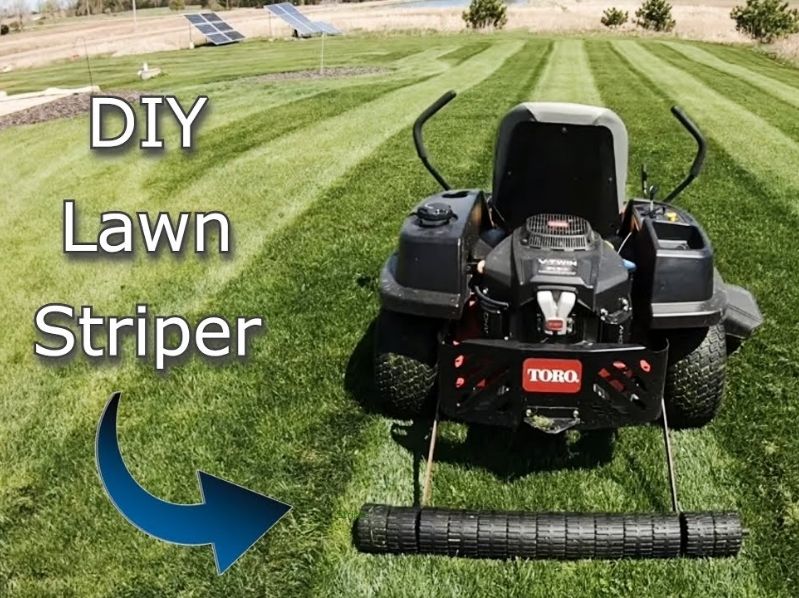Lawn striping is one of those finishing touches that makes a lawn look like it belongs on a ballfield or a magazine cover. Done well, striping can elevate a yard from ordinary to eye-catching. But not every lawn – or mower – is cut out for it. And chasing stripes without understanding how they really work can lead to wasted effort or worse, damaged turf.
This guide breaks down the real benefits of striping, how to do it (with or without special tools), and when it’s best to leave the stripes to someone else.
What Lawn Striping Really Is
Let’s clear something up: striping doesn’t change how your grass is cut. It’s an optical illusion, caused by the way light reflects off grass blades that have been bent in different directions. Mowing one row forward bends the blades away from you. Mowing the next row in the opposite direction bends them toward you. The contrast in light and shadow creates that striped effect.
There’s no paint, dye, or cutting difference – just bent blades and good sunlight.
Do Stripes Help or Hurt Your Lawn?
In moderation, striping is harmless. In fact, alternating mowing directions (a key part of striping) can help prevent rutting and encourage upright growth. But too much pressure – especially from heavy rollers or repeated passes in the same direction – can flatten turf, reduce airflow, and encourage disease, especially in warm, humid climates.
Grass health first, stripes second. Always prioritize your lawn’s growing conditions and recovery time before chasing visual patterns.
What Kind of Grass Works Best for Striping?
Striping works best on cool-season grasses with fine blades and some natural rigidity:
- Kentucky bluegrass
- Perennial ryegrass
- Fine fescue
These grasses tend to grow upright and reflect light well. In contrast, warm-season grasses like Bermuda or Zoysia often grow more laterally and don’t stripe as dramatically – especially in summer when they’re at peak density.

Rule of thumb: If your grass doesn’t show stripes naturally after a few directional mows, it may not be worth pursuing an elaborate striping setup.
Can You Stripe Without Special Equipment?
Yes – and many homeowners do.
If your mower has a rear roller (common on some walk-behinds and reel mowers), you may already be striping. Even without a roller, the weight of your mower and the direction of your cut can create basic patterns.
Tips for DIY striping without a kit:
- Mow slightly higher (around 3–3.5 inches) to give blades more surface to bend
- Keep your blade sharp – ragged tips reduce reflectivity
- Mow in consistent, straight lines with good overlap
- Mow during mid-morning or late afternoon when sun angles highlight contrast
Should You Add a Striping Kit or Roller?
If you’re serious about crisp patterns, a striping roller or drag kit can enhance contrast by bending the grass more consistently. Many kits attach to walk-behind or zero-turn mowers and range from DIY solutions (like weighted PVC) to commercial rollers.
But before you buy, consider:
- Will your grass type respond well?
- Do you mow frequently enough to maintain the look?
- Is your mower compatible with a kit?
- Is striping worth the added weight on your lawn?
Pro Insight: Talk to your local OPE dealer. They can tell you if your mower has a roller option or if a striping kit is even a good idea for your region.
Beginner Striping Patterns to Try
Start simple. These patterns give great results without advanced planning:
- Straight stripes: The classic look. Mow one direction, then back in the opposite.
- Checkerboard: Mow straight stripes, then repeat at a 90-degree angle.
- Diagonal: Adds flair. Follow the same logic but at a slant across your lawn.
- Border pass: Always finish with a perimeter pass to clean up turn marks.
When to Skip the Stripes
Striping isn’t for every yard. Here’s when you might want to pass:
- Your grass is stressed, recovering, or newly seeded
- Your mower lacks the weight or control for straight passes
- Your lawn is heavily shaded (poor light = poor contrast)
- You live in a hot climate where cool-season grass won’t thrive in summer

Common Lawn Striping Mistakes to Avoid
- Using striping rollers on stressed or recently seeded lawns – Can cause damage or delay recovery.
- Trying to stripe warm-season grasses like Bermuda – These don’t show stripes well and can get stressed under pressure.
- Going too low with your cut – Short grass won’t bend enough to reflect light and is more likely to suffer in heat.
- Skipping mower maintenance – Dull blades reduce reflectivity and cause uneven patterns.
- Overdoing it – Repeated striping in the same direction can compact soil and flatten turf over time.
No shame in a solid, well-mowed lawn. Stripes are just icing – not the cake.
Final Cut
Striping can be a fun, satisfying way to show off your mowing skills. But it’s not the holy grail of lawn care – and it’s not worth stressing your turf over. If your lawn responds well and you enjoy the look, go for it. If not, keep your blades sharp, your lines straight, and your lawn healthy. That’s the real joy of mowing.



